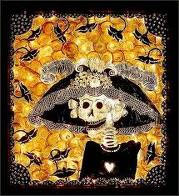La Catrina – Day of the Dead
 José Guadalupe Posada’s work has steadily gained popularity with art lovers and Día de los Muertos celebrators alike. He is especially known for his calaveras images of whimsical skeletons.
José Guadalupe Posada’s work has steadily gained popularity with art lovers and Día de los Muertos celebrators alike. He is especially known for his calaveras images of whimsical skeletons.
Posada, born in 1852 in the Mexican state of Aquascalientes, began his career as a teacher of lithography. In 1887, he moved to Mexico City where he worked as an illustrator for hire.
His work reflected the times in which he lived. While a vast majority of the poverty-stricken population was illiterate, Posada’s illustrations made the stories, news articles, broadsides, advertisements and the many other items his work accompanied easy to grasp.
Truly defining the phrase “a picture speaks a thousand words,” he captured the essence of an emotion, putting it in a form that made it come to life for thousands of people.
Posada was regarded as the voice of the common man and helped to solidify art as a means to communicate the public’s unhappiness and skepticism of the government. He used the practice of caricaturizing figures as skeletons to serve as a sort of satirical obituary.
“La Catrina,” is one such image. While the illustration of the high society woman is one of Posada’s most highly regarded pieces, it’s also arguably the most recognizable image of the Día de los Muertos celebration.
In fact, many of Posada’s calaveras can be seen at Día de los Muertos festivals today. The Caretas (masks) worn at the end of the celebrations to scare the dead away from their altars are often times either reproductions of or influenced by Posada’s illustrations.
The style and sentiment in Posada’s work fueled an artistic movement in the years following his death.


